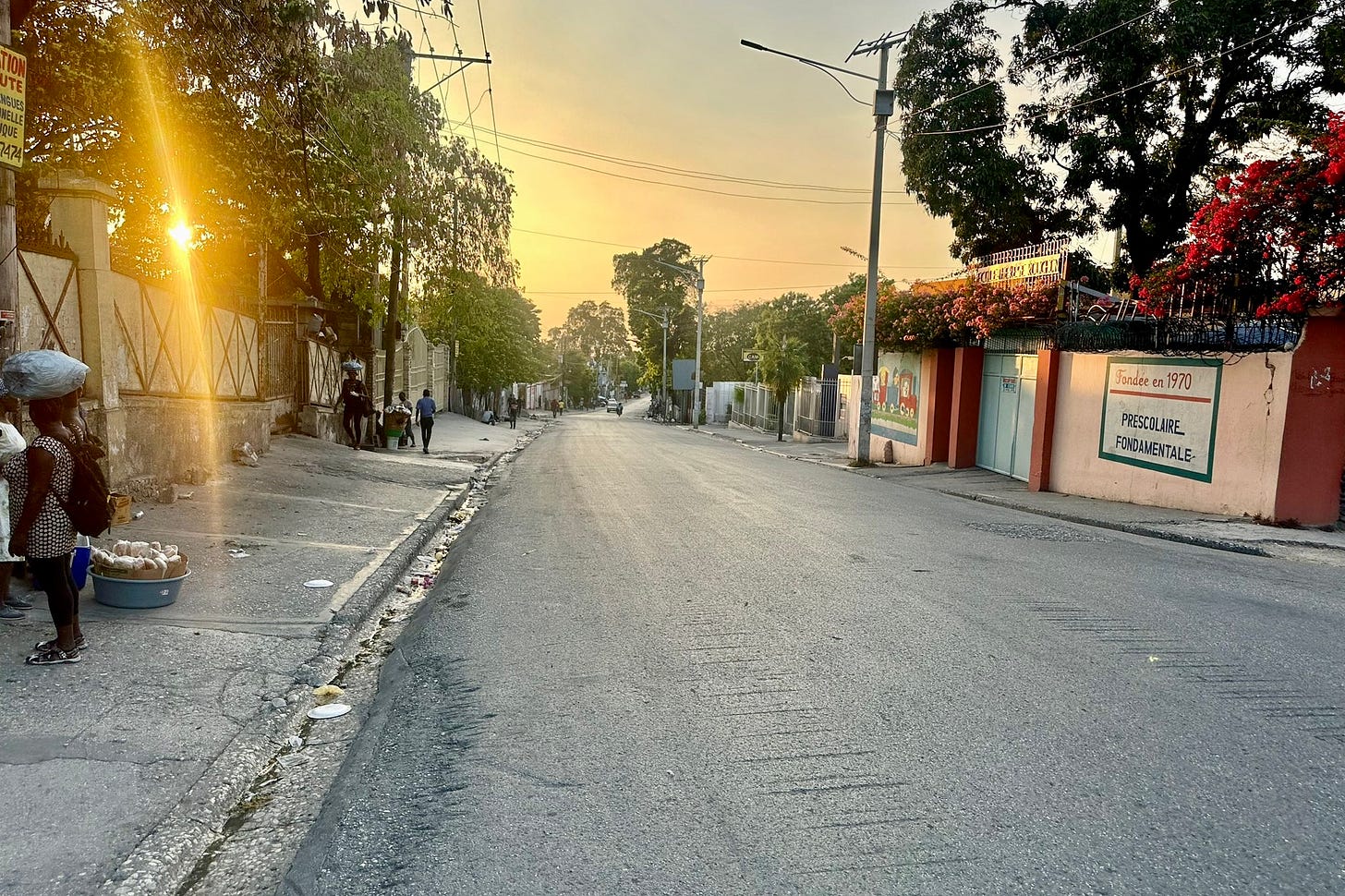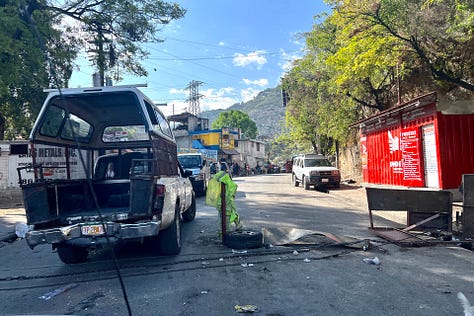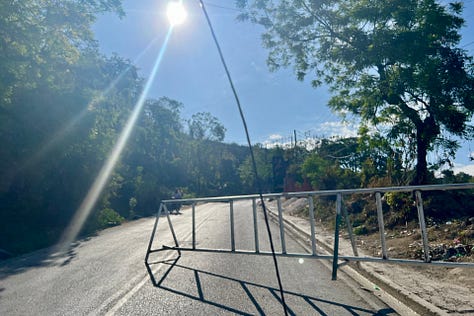#37 - Life at the Time of "Bwa Kale": a Year of Popular Resistance
The Bwa Kale self-defense movement, the largest bus station at a standstill, precarious peace in Cité-Soleil, water flowing in the Ouanaminthe canal and Watson-G back on top

For the past year, the popular Bwa Kale self-defense movement, synonymous with a ruthless fight against suspected bandits through extrajudicial executions, has continued to gain ground. Recently, new barricades were erected from Mirebalais to Canapé-Vert, to block the passage of the criminal gangs that have occupied downtown Port-au-Prince since early March. This a battle to preserve the free districts of the capital is often fought at the cost of blood.
This and more in HAITI WEEKLY #37 by DÈYÈ MÒN ENFO, a collective of journalists and media professionals based in Haiti.
Editor’s note: The DÈYÈ MÒN ENFO team has just returned from northern Haiti, where we worked on a big report, and has been caught up in the news from Port-au-Prince over the past few weeks. We're happy to be back with you and welcome our many new subscribers.
Etienne Côté-Paluck
Summary #37
Bwa Kale: on the front lines of resistance
Portail Léogane: the country's largest bus station at a standstill
Precarious peace in Cité-Soleil
Water flows in the Ouanaminthe canal
Music Video of the week: M nan san by Wenly Jay and Watson-G
Press reviews of the week
Bwa Kale: On the Front Lines of Resistance

The upsurge in armed attacks in Port-Prince since February 29 has reignited the Bwa Kale movement in several neighborhoods that remain free. In areas such as Canapé-Vert, Turgeau, Nazon and others, groups of neighbors have formed brigades to prevent a possible attack by armed criminal groups. Often carried out with the tacit approval of police officers, these actions represent a form of ruthless mob justice. In Delmas 95, for example, two weeks ago, several alleged attackers were executed, the "bandits" usually killed on the spot and sometimes even burned. This radical reaction reflects the almost total obliteration of the country's judicial institution, to the point that some police officers sometimes act as executioners for their detainees, as was the case for two of them a week ago in Lower Turgeau, according to a witness met by DÈYÈ MÒN ENFO.

For more than three years, Port-au-Prince has been under attack by armed youths who rob, kidnap, extort, and even murder residents and passersby in neighborhood after neighborhood. Since the abandonment of the National Penitentiary in early March, these gangs have concentrated on looting downtown businesses, attacking government institutions and police stations that are still active, and vandalizing schools and universities.
The already fragile situation reached a critical point with the complete occupation of the city center by these armed groups in the early days of March, with the notable exception of the building of the Banque de la République d'Haïti (BRH, central bank), which is protected by heavily armed paramilitary forces.



Following the resignation of the Henry government, under pressure from the United States, the Prime Minister is about to hand over to a government of national unity made up of six coalitions or political parties and a representative of the private sector. A curfew has been imposed in the capital, where schools and offices have already been closed for a month, plunging the country into a tense wait.

Despite a certain reduction in frequency, gunfire still echoes through the hills of the capital every night. A few days ago, shots were fired again from the Champs-de-Mars, where police clashed with armed groups heavily last Monday and Tueasday.

For the past month, numerous lifeless bodies have been found along the streets of various neighborhoods on an almost daily basis. Are these violent deaths the result of settling scores or of alleged criminals caught in the act? Most people turn a blind eye, hoping each time that these people really deserved it, but unable to verify the story behind the mostly charred corpses.

In Mirebalais, north of Port-au-Prince, a mob stormed the local police station a week ago, and lynched two people arrested that morning on suspicion of involvement in ammunition trafficking. One of the dead was a plainclothes police officer from the capital suspected of corruption.
Mibalè : Popilasyon an touye 2 prezime bandi, pami yo yon polisye – Centre à la UNE
Mirebalais remains a hotbed for the mobilization of self-defense groups, encouraged by the municipal council, following recent incursions by armed groups from Port-au-Prince. The town is the gateway to the Plateau Central department and lies on the road to the Dominican border. It was on this road, in Belladère, that a man accused of escaping from the capital's prison was lynched by an angry mob last Saturday, according to our partner Centre à la UNE.

As the armed groups’ operations in Port-au-Prince have become more disorganized, their areas of operation have expanded. Initially focused on the city center and the prisons, these attacks are now also targeting residential areas. The attack launched two weeks ago, from the Route de Frères in Pétion-Ville to Delmas 95 and the surrounding area is a good example.
Pétion-Ville under siege, bandits killed - Le Nouvelliste
Haiti - FLASH : Between 30 and 40 killed in Pétion-ville in 5 days - HaitiLibre.com
Downtown Port-au-Prince, already plagued by looting, was not the only area to suffer violence last week. Neighborhoods in the Clercine district, east of the airport, were also the scene of intense gunfire for several days. This period of insecurity finally came to an end last Sunday after a violent police intervention.
The security situation is even more precarious in the northern suburbs of the capital. Croix-des-Bouquets (Bon-Repos, Canaan, Onaville, etc.) is now largely dominated by armed groups. According to a police officer we spoke to, these groups have specifically targeted the police station and the headquarters of the Brigade d'intervention motorisée (BIM) on Place Clercine. This normally lively and bustling area was transformed into an open-air battlefield during some of the clashes.



The armed group known as Chen Mechan (G9) has long dominated many neighborhoods around Clercine. According to information gathered by DÈYÈ MÒN ENFO from local residents, this group has recently welcomed an influx of armed individuals from outside the area. The police intervention intensified late on Saturday night, targeting one of their "bases" near the Croix-des-Missions market. Supported by several armored vehicles, police forces were able to repel several armed men near the police station over the weekend, resulting in several casualties among the attackers.

With the economy paralyzed for the past three years, half of Haiti's population is facing a severe food crisis, a situation almost unprecedented in this tropical country, at least for such a long time. The economy and transportation of almost the entire country depend on Port-au-Prince, which is completely blocked off.

Portail Léogane: the Country's Largest Bus Station at a Standstill

The Portail Léogane station, a major hub for road connections to both Haiti's Grand Sud and all of the capital's neighborhoods, is unusually quiet. The surrounding streets are deserted, and any buses still attempting to reach the south do so at their own risk, preferring to pick up passengers 2 km away on rue Lalue (John Brown). This exodus of bus drivers from their usual station follows the fire and takeover of the Portail Léogane sub-station in early March, which drove them first to rue Saint-Honoré, near the former Rex theater, before the violence pushed them further away. "We run across the street to go home," said a member of the DÈYÈ MÒN ENFO collective, a resident of the area.
Precarious Peace in Cité-Soleil
In a capital shaken by insecurity, Cité-Soleil, particularly the Brooklyn sector, is enjoying a period of calm. Despite fears of escalating violence between rival factions, the local armed group under the command of the nicknamed Ti-Gabriel, a leading figure among the capital's armed groups, has turned away from recent clashes orchestrated by other gangs. Since the creation of the G9 armed collective in 2019, it has been one of its main rivals.
Water Flows in the Ouanaminthe Canal
In Ouanaminthe, the canal project is making significant progress: construction of the junction between the canal and the river, which was to be built dry, is now complete.
The recent acquisition of a mechanical shovel, donated by an influential Haitian pastor living in the USA, has greatly accelerated the pace of the work, which is still ongoing. The diversion of the Massacre River to its natural course has allowed water to flow into the canal for the first time. However, most of the canal's route remains to be determined, as much of it is still in the dirt.
Music Video of the Week
M nan san - Wenly Jay and Watson-G
The partnership between established rapper and singer Watson-G and Wenly Jay has resulted in a major hit that sounds like a hymn to perseverance in the face of life's adversities. In just one month, their collaboration has captivated nearly 2 million viewers on their respective YouTube accounts. The music video illustrates the quest for a better life by showing Watson-G taking on the roles of a bus usher and a mechanic, metaphors for the daily struggle of everyone in the country.
« I'll always be looking for a way to live, to make my life free, because nothing will be given to me. Life can't take any more abuse. I learn from every blow. I'm never afraid of the failures that life presents me with, but when I have to move forward, everything seems to want to stop me. It's as if the misery adds up. Everything I do is blocked. »
Excerpt from the chorus
DÈYÈ MÒN ENFO’s team
Photojournalists: Francillon Laguerre, Sonson Thelusma, Andoo Lafond, Milot Andris, Patrick Payin
Editorial board: Etienne Côté-Paluck, Jean Elie Fortiné, Jean-Paul Saint-Fleur
Interns: Wilky Andris, Donley Jean Simon
Special collaboration: Stéphanie Tourillon-Gingras, Mateo Fortin Lubin, Siffroy Clarens, Jéthro-Claudel Pierre Jeanty, Sadrax Ulysse
Media partners: Centre à la Une, J-COM, Nord-Est Info
Institutional partners: Kay Fanm, Mouka.ht
How Does Your Contribution Help?
Your monthly support helps to finance the production and pay the salaries of the DÈYÈ MÒN ENFO staff in the communities of Cité-Soleil, Port-au-Prince and Cayes-Jacmel. In addition, donations are regularly distributed for medical expenses, school fees and other emergencies in these communities.
Press Reviews of the Week
Keep reading with a 7-day free trial
Subscribe to HAITI WEEKLY by DÈYÈ MÒN ENFO to keep reading this post and get 7 days of free access to the full post archives.









